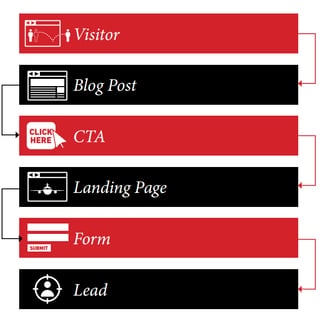With constant growth being crucial to maintain competitiveness in SaaS markets, scaling lead generation is a core challenge.
Even with an effective lead gen process in place, your work is far from over. You need to be continually attracting growing numbers of right-fit visitors, and converting more of them into qualified leads.
Thankfully, there are a few actionable tactics you can use to improve your ability to generate leads. Today, I'm looking at 7 ways you can scale your software lead generation.
1) Increase Content Creation
Most SaaS businesses use free trial or demo offers as their primary method of lead generation. Whilst this can help attract and convert relatively sales-qualified leads, it does nothing to attract visitors that are still in the research stage of the buying process.
That's where content creation comes in. Regular blogging increases search engine and social media visibility, and attracts the many potential visitors in earlie stages of the buying process. By pairing blog posts with a valuable content offer (like a whitepaper or eBook), you can start converting a larger portion of your audience into leads - from tentative researchers, through to ready-to-buy prospects.
2) Expand Your Lead Gen Framework
Effective SaaS lead generation relies on a framework of different tools. Whilst blogging alone will help attract new visitors to your website, to capture their contact details, and turn them into leads, you'll need to enlist the help of calls-to-action, content offers and landing pages. 
Each of these elements of your lead generation strategy needs to be scaled proportionally, with new blog posts accompanied by new offers and landing pages.
Failure to do so will create a bottleneck in your sales and marketing funnel, with a ton of people visiting your site, but very few ever progressing to lead status (or beyond).
3) Improve Call-to-Action Relevance
The more relevant a content offer is to the blog post promoting it, the greater the likelihood of a successful conversion. If a visitor clicks-through to a blog post tackling 'How to Improve Profitability', they're likely to be interested in an in-depth guide on the same topic.
It's a great idea to periodically create new assets for people to download and use; and the more offers and resources you have available, the easier it will be to promote a relevant offer at the end of each blog post.
4) Create Content Campaigns
To consistently achieve this congruence between blog post and content offer, try experimenting with content campaigns.
Whenever you create a new resource, develop a series of blog posts on the same topic: add extra detail, some expert insight or a slightly different perspective. If you're creating a whitepaper, turn each section into its own standalone blog post - and promote the guide at the end of each.
5) Ramp-Up Content Promotion
Blog posts and free resources aren't standalone lead generation tools. Without content promotion, they'll never end-up in the hands of potential customers.
To generate leads, your content needs to be visible to the right people; and to scale lead generation, it's important to be proactive with content promotion, by leveraging as many channels as possible:
- Search engine optimisation.
- Social media promotion.
- Outreach to featured people and interested parties.
- Content syndication on industry-relevant websites.
- Paid advertising to promote blog posts and resources to relevant people.
Learn more: How to Fill the Gaps in Your SaaS Content Promotion Strategy
6) Repurpose Existing Content
Created content assets have a whole lease of life beyond initial publication.
Popular blog posts, whitepapers and videos can be repurposed into other types of content, like infographics, emails and case studies, making it possible to re-promote existing content to a fresh new audience. This offers an additional way to scale-up lead generation without investing a ton of time and energy into the creation of new content assets.
In addition to repurposing existing content, you can also retroactively optimise existing content. By identifying your site's best-performing content, and adding in new CTAs, tweaking keywords and improving linking between internal pages, it's often possible to significantly improve conversion rates.
Learn more: How to Use Old Content to Generate New Leads
7) Optimise Your Landing Pages
The conversion rate of your landing pages is a reflection of how likely visitors are to submit a form, part with their contact details and become a lead. As well as increasing the number of people visiting each landing page, to scale lead gen, it's important to optimise your landing pages to maximise this conversion rate.
There are all manner of tweaks and changes you can make to improve landing page conversion rates; including the optimisation of your contact forms. In most cases, there's a negative correlation between the number of form fields present, and the conversion rate. The more you ask of your visitors, the less likely they are to become a lead.
Learn more: Form Fields and Conversion Rates: Is Less Really More?




